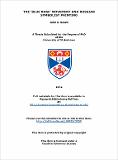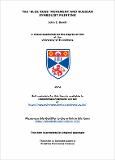Files in this item
The 'Blue Rose' movement and Russian symbolist painting
Item metadata
| dc.contributor.advisor | Haskell, Larissa S. | |
| dc.contributor.author | Bowlt, John E. | |
| dc.coverage.spatial | 565 | en_US |
| dc.date.accessioned | 2013-06-17T10:30:14Z | |
| dc.date.available | 2013-06-17T10:30:14Z | |
| dc.date.issued | 1972 | |
| dc.identifier | uk.bl.ethos.555338 | |
| dc.identifier.uri | https://hdl.handle.net/10023/3703 | |
| dc.description.abstract | The object of this essay is two-fold: firstly, to present an examination of the "Blue Rose" group of artists in the context of Russian Symbolism and secondly, to indicate its importance to the evolution of modern Russian painting. It was felt that while the development of the Russian visual arts of the period 1910-1930 had been studied in some detail, especially by Western scholars over the last few years, the preceding decade was still an obscure and confused field of research: the total absence of any adequate appraisal of the "Blue Rose" movement either in Russia or in the West and my own conviction that this movement warranted particular attention as a vital link between Russian Realism and the so-called avant-garde acted as the prime motives for the completion of this work. In order to justify this assertion I have attempted to consider the emergence of the "Blue Rose" group as part of an organic, indigenous process and to relate it to the achievements of Russian art of the late 19th century. Since the work of the "Blue Rose" group is unknown to Western observers, certain paintings of leading members -Kuznetsov, Sapunov, Sar'yan, Sudeikin--have been analysed in detail; in the case of less active members - Arapov, Peofilaktov,Utkin – a more cursory examination has been presented; since this essay is concerned with the development of easel painting above all, the output of Bromirsky and Matveev (the two sculptors of the group) has been given only marginal consideration. Throughout the text the name, "Blue Rose " has been used to denote that group of sixteen artists who exhibited at the single exhibition of that name in March, 1907. Although the name was used for the first time only at that exhibition, I have applied it in this essay to the group and to individual artists throughout their Symbolist period, i.e. c.1904-1908. The text of this work is based largely on material studied in Moscow between 1966; and 1968. Although original "Blue Rose", paintings are very rare, some examples were found both in public and in private collections: in this respect, access to the store-rooms of the Tret'yakov Gallery, Moscow and the Russian Museum, Leningrad facilitated my task. Published material concerning the genesis and development of the "Blue Rose” group amounts to very little and, therefore, I had to rely heavily on private archives and personal reminiscences of contemporaries as well as on more general sources such as the Symbolist journals and memoirs: in this respect, of particular value were the manuscript of Arapov's autobiography, the diaries and documents of P. Kuznetsov, the unpublished guide to the reserves of the Tret'yakov Gallery and the oral collections of the late V. M. Lobanov; W. Nouvel's unpublished monograph on Diaghilev provided me with useful material in my study of the "World of Art”. In addition, relevant written material was found and consulted in the Lenin Library, Moscow, the Tret'yakov Gallery Library, Moscow, the Pushkin Museum of Fine Arts, Moscow, the Central State Archives of Literature and Art, Moscow, the Saltykov-Shchedrin Library, Leningrad, the Russian Museum Library, Leningrad; in the West extensive use was made of the facilities of the British Museum, the Victoria and Albert Museum, the Library of the School of Slavonic and East European Studies at the University of London, the Library, of Congress, the New-York Public Library and the Widener Library, Harvard. Because of the complete absence of Russian exhibition catalogues of the Symbolist period in the West, and of their rarity in Russia, detailed listings have been made where relevant to the text. In the case of the “Crimson Rose" and "Blue Rose" exhibitions the participators and their contributions are listed in full in Appendices I and III; this is because only one copy of the former is known to exist (in the library of the Leningrad Academy of Fine Arts) and only two copies of the latter have been located. In these instances and in those of the "Golden Fleece" exhibitions the original Russian has been retained in order to avoid that constant confusion which translation and retranslation of picture titles has caused in the West. The illustrations are from pictures in Russian public and private collections and, in some cases, where the original has been lost or has not been traced—from reproductions in contemporaneous books and journals. The system of transliteration is that used by the journal, Soviet Studies (published by the Institute of Soviet and East European Studies, Glasgow), although where a variant has been established already this has been used, e. g. Diaghilev (not Dyagilev), Jawlensky (not Yavlensky). | en_US |
| dc.language.iso | en | en_US |
| dc.publisher | University of St Andrews | |
| dc.rights | Creative Commons Attribution-NonCommercial-NoDerivs 3.0 Unported | |
| dc.rights.uri | http://creativecommons.org/licenses/by-nc-nd/3.0/ | |
| dc.title | The 'Blue Rose' movement and Russian symbolist painting | en_US |
| dc.type | Thesis | en_US |
| dc.type.qualificationlevel | Doctoral | en_US |
| dc.type.qualificationname | PhD Doctor of Philosophy | en_US |
| dc.publisher.institution | The University of St Andrews | en_US |
This item appears in the following Collection(s)
Except where otherwise noted within the work, this item's licence for re-use is described as Creative Commons Attribution-NonCommercial-NoDerivs 3.0 Unported
Items in the St Andrews Research Repository are protected by copyright, with all rights reserved, unless otherwise indicated.



